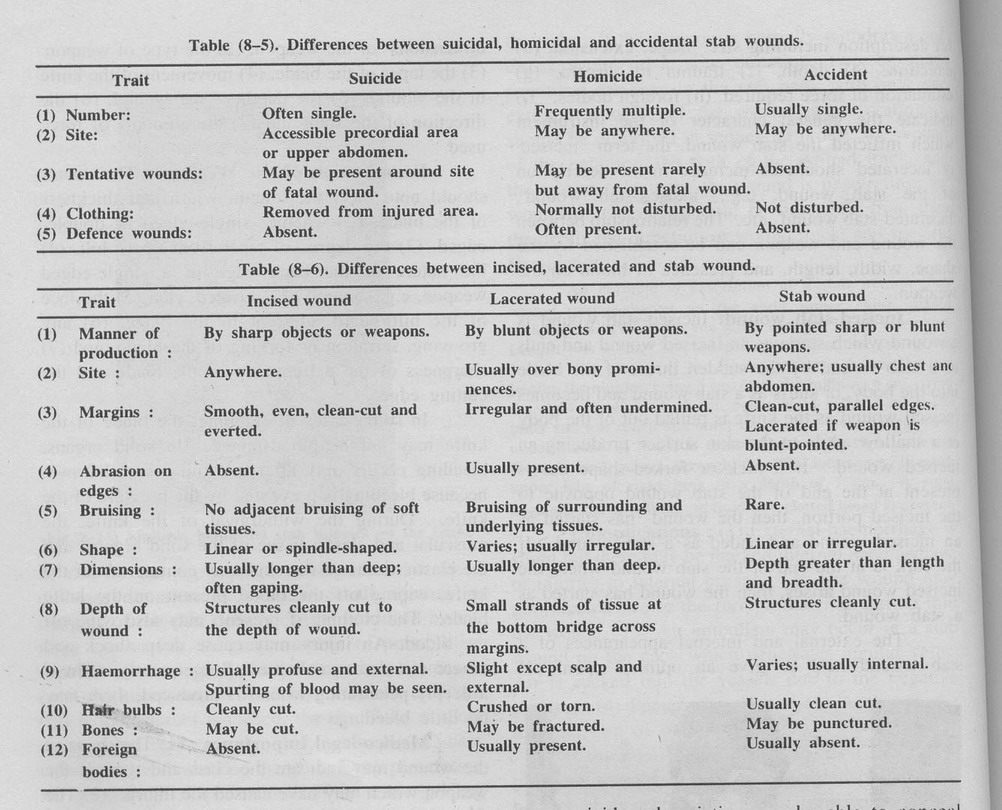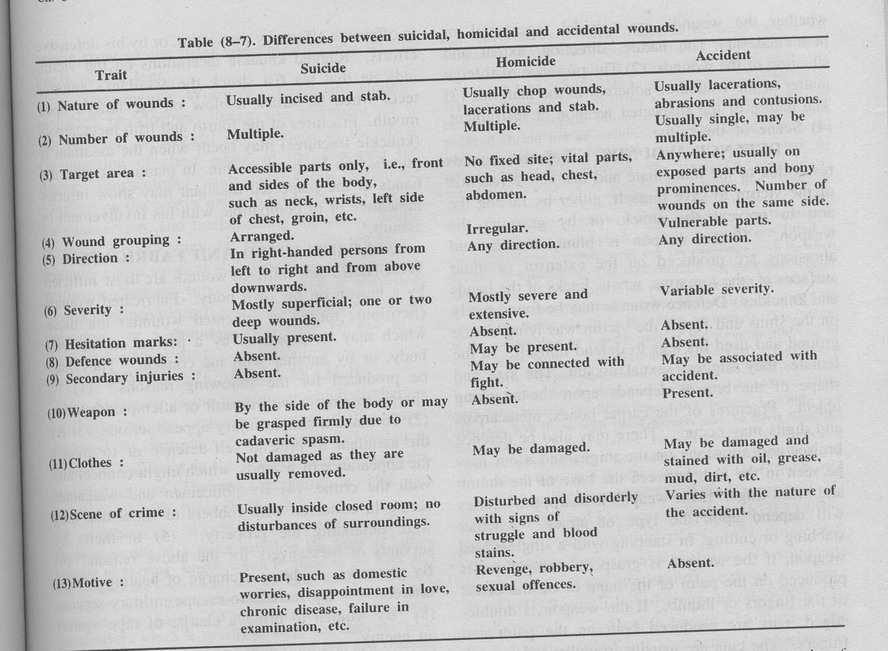
- •Mechanical injuries
- •Table (8-1). Difference between ante-mortem and post-mortem abrasions.
- •Contusions (bruises)
- •In interpreting the age of a bruise by colour changes, one should be very cautiousT)
- •Table (8-2). Difference between hypostasis and bruise.
- •Injury; may appear anywhere on the body.
- •Lacerations
- •If asleep, blood runs down on both sides of the neck and collects behind the neck and shoulder; stains found on both palms, for the victim attempts to cover the wound.
- •Incised wounds of the arms are almost always
- •Is repaired.
- •Table (8-5). Differences between suicidal, homicidal and accidental stab wounds
Table (8-5). Differences between suicidal, homicidal and accidental stab wounds

variable, some are superficial and others enter the pericardium or heart. The suicide may not withdraw the point of the weapon from the skin, and stab himself repeatedly in different directions through the same skin wound. Rarely one stroke is fatal, and the knife may be found sticking in the wound. In many cases, even multiple stabs do not cause death and the person may resort to other methods which present a puzzling picture. Stab wounds of the head are rare. Usually, a number of stabs extending only to the bone are seen in the temporal region. Suicidal stab wounds of the spine, abdomen, neck and extremities are rare. Wounds found on a part of the body usually covered by clothes without corresponding cuts or rents on them are suicidal, as a person who commits suicide exposes his body by opening his clothes and then inflicts wounds. In some suicides, the victim may be able to conceal the weapon.
Hara-kiri: It is an unusual type of suicide, in which the victim inflicts a single large wound on the abdomen with a short sword while in a sitting position or falls forward upon a ceremonial sword and pulls out intestines. The sudden evisceration of the internal organs causes a sudden decrease of intra-abdominal pressure and cardiac return. producing sudden cardiac collapse.
Jjiomicide: Most deaths from stab wounds are homicidal, especially if found in an inaccessible area. The wounds are multiple, widely scattered and deeply penetrating, involving the chest and abdomen. In case of a sudden surprise attack, a single wound is found at a vital spot, If there is a struggle, there
Table (8-7). Differences between suicidal, homicidal and accidental wounds.

may be a number of wounds, sometimes associated with defence cuts on the hands. In a few cases, a number of wounds may be found in a localised area, almost of the same depth. These occur when the assailant threatens the victim, who is held by another assailant. These wounds are usually seen on the face or neck, and may be far away from the fatal injury. Homicidal stab wounds of the chest may have any direction, but the common direction is at an angle from left to right and from above downwards. Fatal stab wounds of right chest usually injure right ventricle, aorta or right atrium. Stab wounds of the left chest usually involve the right ventricle when parasternal, and left ventricle as the stab wounds become more lateral and inferior. Severing of the left anterior descending coronary artery is rapidly fatal. Most stab wounds of the heart ind lungs occur over the front of the chest, rarely the sides, and least on the back. Stab wounds of the lower chest can injure the heart and lungs and also abdominal viscera. Rarely a single stab may produce multiple skin wounds, such as tangential stab of the arm may pass through superficial tissues and then enter the chest wall, or stab through a sagging female breast can pass through the edge and re-enter the thorax.
Accident: Accidental wounds are rare. They are causecHry-fefmig against projecting sharp objects like glass,, nails, etc,., or a person may be gored by the horns of a bull, buffalo, etc. An upward or downward track is quite inconsistent with an accidental stab wound. Impaling injuries are caused when a person falls or jumps from a building and lands on a fence.
Accidental, self-inflicted or inflicted by others: The following factors arc helpful lo determine
whether the wounds are suicidal, accidental or homicidal. (1) The nature, direction, extent and situation of the wounds. (2) The presence of foreign matter in the wound or adherent to the margins. (3) The nature of the suspected weapon or instrument. (4) Scene of the crime.
DEFENCE WOUNDS : Defence wounds result due to the immediate and instinctive reaction of the victim to save himself, either by raising the arm to prevent the attack, or by grasping the weapon. If the weapon is blunt, bruises and abrasions are produced on the extensor or ulnar surfaces of the forearms, wrists, backs of the hands and knuckles. Defence wounds may be found rarely on the shins and feet if ihe victim was lying on the ground and used his legs to defend himself. In the female, they suggest sexual assault. The size and shape of the bruises depends upon the attacking object. Fractures of the carpal bones, metacarpals and digits may occur. There may also be defence bruises and abrasions on the thighs and a cut may be seen in the web between the base of the thumb and index finger. If the weapon is sharp, the injuries will depend upon the type of attack, whether stabbing or cutting. In stabbing with a single-edged weapon, if the weapon is grasped, a single cut is produced on the palm of the hand or on the bends of the fingers or thumb. If the weapon is double-edged, cuts are produced both on the palm and fingers. The cuts are usually irregular and ragged, because the skin tension is loosened by gripping of the knife. When attacked, the victim usually holds up the hand or forearm and receives cuts on the hand, wrist, ulnar border of the forearm and on the fingers. They are often irregular in depth and distribution. A typical knife defence wound is seen in the web between the base of the thumb and index finger, when the blade is grasped. Rarely, defence wounds are found on the feet or legs, e.g. when the victim kicks at the knife, or curls up and tries to cover vital areas with his legs. Defence wounds indicate homicide. Defence wounds are absent if the victim is unconscious, or is taken by surprise, or attacked from the backi or under the influence of alcohol or drugs.
Offensive Manual Injuries: Abrasions and contusions over the knuckles can be sustained due
to offensive efforts by the victim, or by his defensive efforts. Ragged knuckle lacerations on the victim indicate that his fist struck the assailant's anterior teeth when he struck a blow on the latter1 s open mouth. Fractures of the fourth and fifth metacarpals (knuckle fractures) may occur when the assailant is punched on his head or chin. In manual assault, the hands of the suspected assailant may show injuries indicative of or compatible with his involvement in assault.
SELF-INFLICTED AND FABRICATED WOUNDS : Self-inflicted wounds are those inflicted by a person on his own body. Fabricated wounds (fictitious, forged or invented wounds) are those which may be produced by a person on his own body, or by another with his consent. They may be produced for the following reasons. (I) To charge an enemy with assault or attempted murder. (2) To make a simple injury appear serious. (3) By the assailant to pretend self-defence or to change the appearance of wounds, which might connect him with the crime. (4) By policemen and watchmen acting in collusion with robbers to show that they were defending the property. (5) In thefts by servants or messengers for the above reason. (6) By prisoners, to bring a charge of beating against officers. (7) By recruits to escape military service. (8) By women to bring a charge of rape against an enemy.
Fabricated wounds are mostly incised wounds, and sometimes contusions, stab wounds and burns. Lacerated wounds are rarely fabricated. Incised wounds are usually superficial, multiple and parallel. The direction is from behind forwards on the top of the head, from above downwards on the outer side of upper arm, from below upwards on the front of forearms, variable on the legs and vertical on the abdomen and chest. Stab wounds are usually multiple and superficial and seen about the left arm or shoulder and sometimes on the chest. Burns are superficial and seen usually on the left upper arm. The clothes are not cut and if cuts are seen they are not compatible with the nature of the wounds. The history of the assault is incompatible with the injuries.
Old linear scars in sites of election suggest previous similar attempts. They are seen on the face,
MECHAN1CA
11 the front of the trunk, on the arms and on the fronts of the legs.
Therapeutic Wounds : These are wounds
produced by doctors during the treatment of a
Mtient, such as surgical stab wounds of the chest
1 insertion of chest tubes, of the abdomen for
mns, thoracotomy and laparotomy incisions,
visions on the wrists, antecubital fossae and ankles
.or venesection, and tracheostomy incisions. Some
of these wounds may be mistaken for traumatic
wounds, e.g. a surgical stab wound of the chest for
putting a drainage tube. Sometimes, a traumatic
wound may be enlarged and included in the surgical
procedure, or a drainage tube may be put in a
homicidal stab wound.
